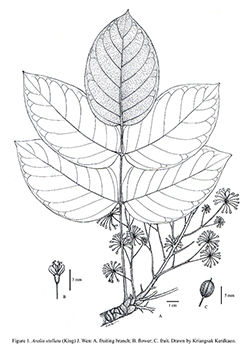e-Flora of Thailand
Volume 14 > Part 2 > Year 2019 > Page 194 > Araliaceae > Aralia
7. Aralia stellata (King) J.Wenwfo-0000259471
Acta Bot. Yunnan. 24(5): 566. 2002; J.Wen, Cathaya 13–14: 55, fig. 22. 2002; Frodin & J.Wen in Frodin & Govaerts, World Checkl. Bibliogr. Araliac.: 75. 2004 (‘2003’).— Pentapanax stellatus King, J. Asiat. Soc. Bengal, Pt. 2, Nat. Hist. 67: 293. 1898. Fig. 1. Plate IX.
Accepted Name : This is currently accepted.
Synonyms & Citations :
Description : Shrubs or treelets to 6 m tall, dbh to 9 cm, bark grey, thin, flaking; branches to 1 cm in diam., not spiny, glabrous. Leaves: stipules inconspicuous, only as clasping leaf base; petiole 9–10 cm long, with a broadly sheathing base, with few hairs to glabrous;: blade once pinnate, to ca 25 cm long, rachis with prominent ridges above; leaflets 3–5, the terminal one with a 20–60 mm long petiolule, the lateral ones subsessile (petiolule to 6 mm long), orbiculate to elliptic, 8.5–17 by (4–)6.5–15 cm, base truncate, sometimes cordate or attenuate, margin with sparse, indistinct teeth, appearing nearly entire, apex rounded to mucronate or shortly acuminate, glabrous above, densely woolly hairy beneath with midrib and veins ± glabrous; midrib and veins slightly prominent above and beneath, veinlets usually sunken above, hardly visible beneath, side veins in 7–10 pairs, becoming congested near base. Inflorescences terminal, surrounded at base by triangular scaly bracts ca 7 mm long, in several whorls, usually several inflorescences crowded, 13–35 by 8–30 cm, with a main axis of similar length and much narrower than the stem, and numerous (at least 7) lateral umbels, each on a peduncle of 3.5–9 cm and with 2–8 smaller additional umbels, with scattered pubescence throughout, lateral branches subtended by a narrow, caducous bract 3–10 mm long; umbels 15–40-flowered, 17–30 mm in diam. (to 40 mm in fruit); floral bracts linear, ca 1 mm long, glabrous to subglabrous. Flowers: pedicel 6–13 mm long, pubescent; flowers whitish; petals pale green, ca 2 by 1–1.5 mm, free; styles 5, upright in young flowers, later united into a stylar column of ca 1 mm, apically free for ca 1 mm, deeply bifid, reflexed in fruit. Fruits 4 by 4 mm close to maturity, deeply sulcate.
Thailand : NORTHERN: Chiang Mai (Doi Chiang Dao, Doi Nom), Nan (Doi Phu Kha).
Distribution : Myanmar (type).
Ecology : Undershrub in degraded deciduous seasonal forests, in open evergreen and deciduous hardwood forests, in rocky areas, on limestone, 1,500–1,800 m alt. Flowering and fruiting: November–January.
Vernacular : Hun kwang (หุนกวาง).
Notes: The dense, woolly indumentum beneath the once-pinnate leaves makes it easily distinguishable from all other species.


